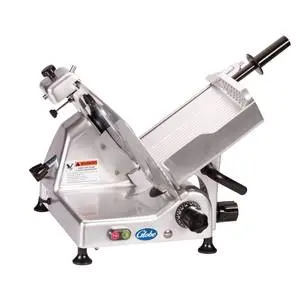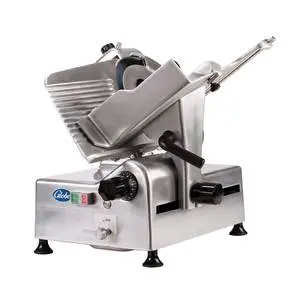The primary function of a slicer is to create uniform slices of different types of foods. We will mainly discuss meat and cheese slicers here as they are the more advanced equipment and used in a large variety of restaurants.
One of the primary benefits of a slicer is the consistency it allows, whether it is to slice perfect portions of meat in your deli or to deal with large volumes of cheese. Slicers not only give certain foods a neat appearance but they also offer space saving benefits for food storage and minimize food prep workloads.
Understanding how to properly select, use and maintain your commercial slicers will help you get most bang for your buck from these useful items.
Slicers Basics
As mentioned, there are various types of slicers; from fruit and vegetable slicers and baguette slicers, to multipurpose slicers than can be used for various functions. Among the most popular are meat and cheese slicers.
These come in the form of manual, a device you slide with your hand, and automatic slicers, which run electronically. A manual slicer has to be operated by a staff member. These are more widely used and work well in low volume environments. An automatic slicer performs the slicing motion without an operator, and is best used in an environment that requires a large amount of sliced product.
Commercial Slicer Parts & Operation
Some major components of a meat or cheese slicer include:
- The blade – used for slicing the product
- Carriage slicer knob – for adjusting the cut of the meat (thinness/ thickness)
- On/off switch – for powering the automatic device on or down
- Rubber Feet – for stabilizing the slicer onto a flat surface
- Sharpener – for sharpening the slicer blade
- Replace Blade Cover – A protective cover for the slicer blade when not in use
To use a meat or cheese slicer:
- Rotate the adjustment knob to set the thickness desired
- Use the weight handle to apply pressure on the food product that is being sliced
- Push the carriage back and forth over the blade, while catching falling pieces of meat with your other hand
- Make further thickness adjustments as necessary
- To begin automatic slicing you will pull the start /stop button and push it in to end automatic slicing
What to Consider When Purchasing Your Slicer
Design features vary based on the type of slicer you choose for your unique needs. Design features to consider when choosing a slicer for your foodservice establishment include:
- Manual vs. Automatic: An automatic slicer, also known as an electric slicer, can slice a higher volume of product at a faster rate. Some operators prefer an electric option due to its low requirement for constant staff attention. Consider the demands your establishment must meet when coming to a decision.
- Blade Size - Meet and cheese slicers come with blades in 9' to 14" diameter. 12” is industry standard.
- Horsepower – It is recommended you select a slicer with high horsepower if you will be operating with heavy volume. High horsepower is a good option for deli shops and grocery stores.
- Typically, slicers come in light, medium and heavy duty. For usage in restaurants, you will want a slicer that can meet the demands of regular usage.
- Light Duty Slicers are not highly recommended for food service establishments but may be appropriate for light usage such as churches, concession stands and similar operations that operate occasionally.
- Medium Duty Slicers can slice at most for a few hours per day. This is a good option for a low touch environment such as a small grocery store with a low traffic deli area.
- Heavy Duty Slicers can slice any amount of cheese, meat and even can cut into frozen food product
Safe Usage & Cleaning
There are many way to protect yourself when using a slicer. First, respect the fact that it is a rotating blade that has the potential to hurt you. Second, understand the operation of the slicer. Here are a few more tips:
- Wearing cut-resistant gloves for added protection is a great way to enhance safety when both cleaning and using a meat or cheese slicer.
- If the slicer has multiple modes, it’s best to ensure the equipment piece is in manual mode if not in use.
- Always use the food pusher rather than your hands, regardless if they are glove protected.
- You want to pay close attention to the task at hand when operating a slicer, therefore distractions such as reaching over the slicer, or attempting to multitask in any way is strongly discouraged.
- The safety switch is there to protect you, and should not be tampered with as it can result in a major injury.
- Keep your slicer clean. It helps maintain the slicer’s performance plus removes potential sanitation issues.
Sanitizing your machine daily is recommended. You can clean your slicer by follow a few simple steps:
- Make sure the slicer is unplugged. Also ensure the gauge plate is in a fully closed position.
- Open the product tray by unscrewing the knob.
- Remove the blade face plate by removing the nut on the back side of the unit.
- Remove food particles from the front side of the blade.
- Wash, rinse, and sanitize machine parts using degreaser spray or a soapy cleaning solution with half hot water and half dish soap.
- Let air dry.
Compare the Top Commercial Slicers
Vollrath ,Globe, and Berkel are top manufacturers of slicers in the foodservice industry.
Vollrath – Vollrath offers slicers for your catering business, a deli, or supermarket. With items designed to save counter space and provide durability. This brand is competitive amongst its peers.
Globe – Globe prides themselves on providing high-quality slicers that meet the demands of any size operation. They offer slicers in models S and N series Premium Heavy Duty, G series Medium Duty, and C Series Economy to meet all needs.
Berkel – For the past century, Berkel has developed reliable equipment for the food service industry, including their quality foodservice slicers.



